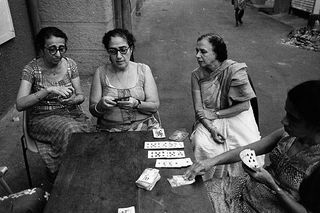
Kitty Parties Were Never About the Gossip; They’re About the Women
The monthly tradition serves up social and intellectual stimulation.

Do women have time in their busy schedules to meet at a certain date and time every month, and pay to simply whisper about scandals in their neighborhood and whine about their lives? No.
So, how did the kitty party get such a baseless stereotype?
The kitty party is a rotating savings association, wherein the member women pay a certain amount at every meeting into the pool, or kitty. The host gets the collected sum of money; each member has to host the kitty once every round. A round ends once this system rotates through all the members of the kitty, and then another one begins.
I grew up hearing people scorn such events, dismissing them as fanciful or frivolous — for bored housewives. But the afternoon soirees I tagged along to with my grandmother were socially and intellectually stimulating for the women involved, and served as a safe space for exchange of information and ideas.
Historically, because of the ghar/bahir divide, “women are regarded as belonging in the home and men in the public world,” according to Norwegian social anthropologist Anne Waldrop, who conducted research into kitty parties in Delhi in the 2000s. This “restricts women’s movement in the public space and in areas outside the view of their husbands.” With globalization and changes in middle class values, women have started to engage in paid work. The kitty party, however, exists outside the two main “proper” places of women — at home or at work — and hence, must be a frivolous, selfish endeavor of no value, Waldrop said.
The stereotype encountered by Waldrop during her research was that it was for women with nothing better to do. “The women participating in the kitty party were well aware of these negative stereotypes, and would also in front of me, say that it was nothing special,” she said. “Still, it was my clear impression that it meant something to the women.”
Related on The Swaddle:
The SATC Feud and the Myths of Female Friendship
Traditionally, women have used the kitty party to increase their economic flexibility and exert some semblance of control over their money, a responsibility that men typically have had in Indian families, according to Waldrop, now a professor of development studies at the Oslo Metropolitan University. They also used the money to buy luxury items for themselves and engage in self-pampering — activities most women felt they were undeserving of, according to the interviews Waldrop conducted and chronicled in chapter seven of Being Middle-Class in India: A Way of Life.
Documentation of woman-to-woman friendships has also been rare, as women have historically been confined to the family sphere, Waldrop adds. The kitty party gave women a space to explore friendships and share grievances, which society otherwise made difficult for them.
Almost every traditional kitty party includes ‘drawing the kitty,’ which is picking a chit to determine who will host the event next month. There is usually a game of Housie, akin to Bingo; a few host-selected games to test the members’ knowledge of pop culture, politics, language skills, etc., followed by a feast of (usually home-cooked) snacks.
In addition to the set itinerary, women discuss fashion, entertainment, their traveling escapades, and their families. The kitty party serves as a support group for sharing problems regarding partners and children, and also as a real-life Quora thread for discussing the best tutors and schools and solutions to any common health ailments its members suffer from.
“For me, gossiping is not something I am interested in. Today, I doubt ladies have much time for that,” said Jagruti Parmar, who has been attending kitty parties for 15 years. “The perspectives are broader. Ladies have the mindset that, today, let’s learn something new.”
Some kitties, like Parmar’s, host cooking and arts-and-crafts demonstrations. For the women nearing menopause in her group, the kitty also hosts gynecologists, who give lectures on the best eating and exercise practices for them, she said. Another common practice is charity, wherein the women pool money to donate to a local children’s shelter, or to underfunded schools.
Another kitty charges women Rs. 5 for coming late to the party, which they pool until the end of the round and then use to help their housekeepers with their children’s school fees, according to member Smita Thakkar.
In her kitty, the women have set aside 15 minutes toward the end of the party for members to bring up interesting things they learned in the past month — be it news, an interesting book they read, a YouTube video they watched, or a spiritual lesson they learned. In the past, some Jain women have questioned the religion’s stipulations banning the consumption of certain foods, she said, and the entire kitty talked it through.
Stressing the importance of expanding one’s own knowledge, Thakkar said, “You are supposed to know first, before you teach your kids.”
Related on The Swaddle:
The Case For Platonic Intimacy
Most of all, women have emphasised that the importance of the kitty party lies in them being able to get out of the house and meet friends, according to Waldrop’s research.
“Ladies are busy with children, with work, with family. Kitty parties are the place where they get me-time,” Parmar said. “For one or two hours, they forget about their duties, what they have to do. It’s something you do only for yourself.
And the best part is, nothing is compulsory. Anything you do is absolutely by your own choice.”
A safe space where women can exert their economic and social autonomy, while having fun with friends and helping local communities? Yes, that, women do have time for.
Rajvi Desai is The Swaddle's Culture Editor. After graduating from NYU as a Journalism and Politics major, she covered breaking news and politics in New York City, and dabbled in design and entertainment journalism. Back in the homeland, she's interested in tackling beauty, sports, politics and human rights in her gender-focused writing, while also co-managing The Swaddle Team's podcast, Respectfully Disagree.
Related


The Buzz Cut: Mattel’s Astrophysicist Barbie Feels Like a Marketing Ploy
